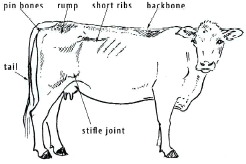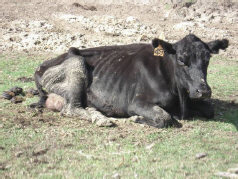



Welfare Decisions For Beef Cows
By Ian Blackwood Beef Adviser, Extensive Industry Development, Bob Gaden Technical Specialist, Extensive Industries Development, Brett Littler Beef Adviser, Extensive Industry Development, Amanda Paul Veterinary Officer, Animal Welfare Branch, Kylie Prowse RSPCA Inspector. Published by NSW Department of Primary Industries.
Introduction

Key assessment sites
At times such as during drought, reduced feed intake causes beef cows to lose body condition. As this happens, they progressively become infertile, their milk dries up and their commercial beef (salvage) value declines.
If they lose condition further, their body reserves can become insufficient for them to withstand mustering, yarding, transport or sale. If they become very weak they are at risk of death during wet weather or if placed under any form of stress. It is unacceptable to the community and is illegal to allow stock to reach this condition.
Livestock managers, advisers, transport operators and welfare officials need to make decisions about feeding, suitability for transport or sale of cattle and, in extreme cases, their humane destruction on the property. These decisions are difficult, and often must be made by people under heavy emotional stress.
This document is intended to give clear, practical guidelines on assessing the status of affected cows and on deciding what should be done with them.
Assessing animals
The diagram below shows the key sites for assessing an animal’s status. Use the chart over the page to decide the status of animals and the action required.|
Welfare Decisions
|
|||
| Fat score 1 | Poor | Very poor | |
|---|---|---|---|
 |
 |
 |
|
| Brief description | Lean but strong and healthy and with no significant muscle wastage. Reduced reproductive performance likely. | Healthy but with significant muscle wastage. Unlikely to conceive. Able to recover in time if adequately fed. | Weak, with very low body reserves. At risk of death from cold, wet weather or other stress. Recovery dependent on high quality care and will be slow. |
| Transport, sale | Suitable for transport and sale but with minimum time off feed | Unsuitable for sale through saleyards or transport over long distances | Not fit to travel |
| Backbone | Easily seen. | Spines of backbone identifiable. | Spines of backbone individually identifiable. |
| Short ribs | Visible but not individually. Fairly sharp to touch | Prominent and very sharp to touch | Very prominent and easy to see individually |
| Inside pin bones | Slightly sunken | Sunken | Deeply sunken to the bone |
| Muscle wastage | Rump muscle concave (between hooks and pins). | Rump muscle concave. Muscle wastage in loin and leg muscle evident. | Muscle wastage obvious over whole body. Rump and leg muscles deeply concave. |
| Stifle joint | Stifle joint not identifiable | Stifle joint identifiable | |
| Tail bones | Individual bones not identifiable. | Individual bones just able to be felt. | Individual bones easily felt. |
| Skin | Pliable. | Less pliable. | Tight. |
| Mobility | Normal gait. | Mobile, able to lie down/rise with ease. | Unsteady gait, may drag hind feet or plait hind legs. Difficulty lying down/standing up. |
| Ability to calve | Some assistance required. | Moderate assistance required. | High level of assistance required. |
| Actions required |
|
|
|
Criteria for destruction on property
Some cattle may require humane destruction on property. They should be destroyed if they in poor or very poor condition as described above and meet any of the following conditions:- Fall down or are knocked over easily.
- Unable to stand without assistance.
- Very unsteady gait, staggering, plaiting in hind legs.
- Adequate good quality feed cannot be provided.
- Adequate good quality water cannot be provided.
- Uneconomic to transport, sell or feed.

May 2007 © State of New South Wales, Australia.


